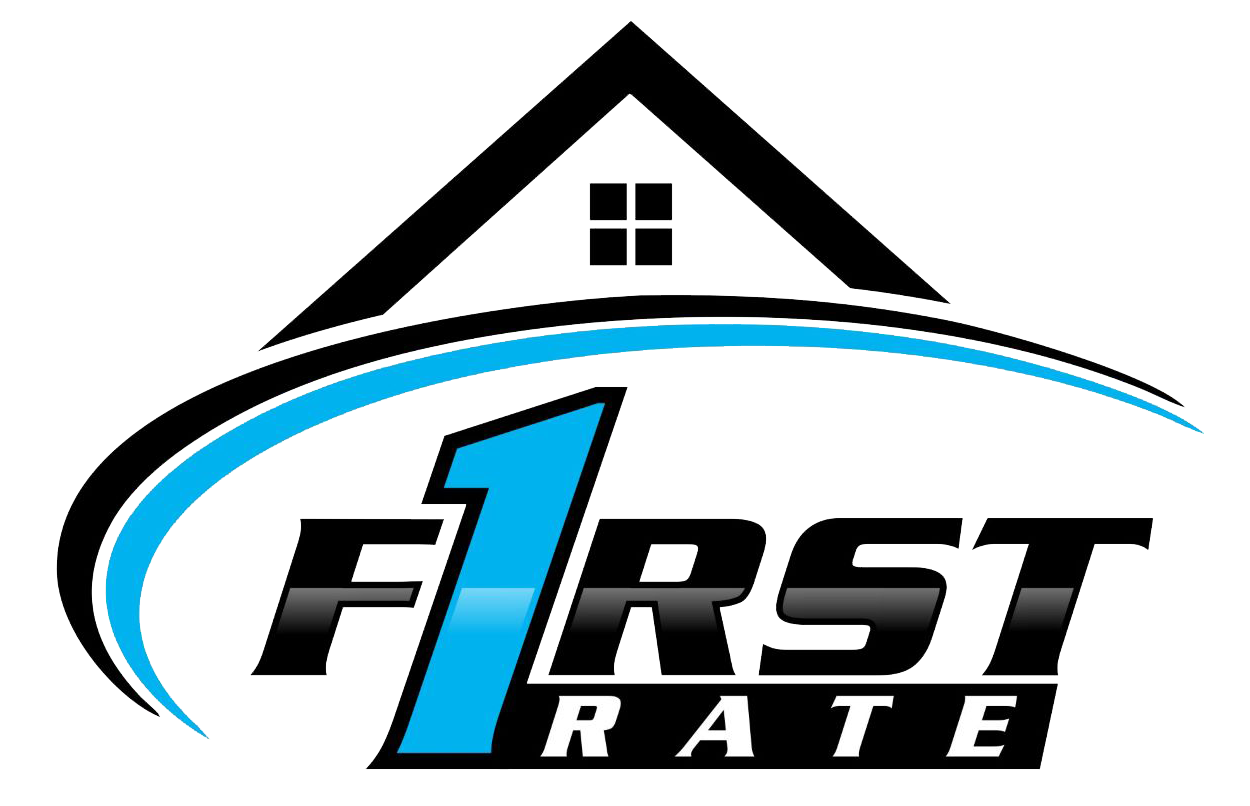Charm Booklet
Consumer handbook on adjustable-rate mortgages
Items Needed Checklist
Checklist for Loan and Purchase Qualification
Home Loan Toolkit
How to Cancel PMI
Private Mortgage Insurance Cancellation and Termination
Tips for a Refinance
Tips for Buying a Home
What is Mortgage Insurance?
Same Service, Less Charge
First Rate Financial simply offers you the same service as the larger banks, but with less charge.
You will find a combination of rates and fees much lower than your local or national bank/lender. We want you to receive a great deal with great service so you’ll never need to call another mortgage company again. Our goal is to become your lender for life.
The Great Things About First Rate
- First Rate has a PERFECT reputation with no online review less than 5 stars! Look for yourself!
- The BEST combination of low rate and closing costs versus our competition.
- Our approach is a refreshing honest, up front way of communicating with our clients… we tell the customer what they NEED to hear over want they WANT to hear.
- We close on time! We close on time! We close on time!
- There are no last minute “surprises” that make the home buying process stressful.
- E-signature and electronic upload technology to reduce paperwork and increase safety while making the process smooth and efficient.
- If you need someone, you can get us! We can be reached on weekends and weeknights.
Mortgage Broker in Frisco, Texas
First Rate Financial is a Mortgage Broker located in Frisco, Texas. Our goal is to achieve such a high level of satisfaction for our clients that we will receive repeat and referral business.
When looking for a home loan or beginning the process of refinancing a home, your first step is to undergo a pre-qualification process. Once pre-approved, there will be some other formalities
to go through as well. (processing paper work, checking credit, etc.)
It will be necessary to fill out a 1003 mortgage loan application completely. At the time of application, you may also be provided with a list of items that MUST be returned with your loan application. If these items are not turned in, this will delay getting your loan or losing your interest rate, if the processing period goes beyond quoted lock period. We will make sure to set an expectation of each milestone so the client will know when certain items are due.
First Rate Service to First Rate People
After the initial docs are received, the file (your loan) goes into processing. You will be contacted as additional documents are needed. At that time, we are trying to get your mortgage loan closed!
All and all, the mortgage process can be very smooth, simple, and quick if you choose the correct company to help your needs. With over 15 years of experience in the Texas market, First Rate Financial is the one to choose. We provide first rate service to first rate people!
Abstract of Title
A historical summary provided by a title insurance company of all records affecting the title to a property.
Acceleration Clause
Allows a lender to declare the entire outstanding balance of a loan immediately due and payable should a borrower violate specific loan provisions or default on the loan.
Adjustable Rate Mortgage (ARM)
A variable or flexible rate mortgage with an interest rate that varies according to the financial index it is based upon. To limit the borrower’s risk, the ARM may have a payment or rate cap. See also: cap.
Amenities
Features of your home that fit your preferences and can increase the value of your property. Some examples include the number of bedrooms, bathrooms, or vicinity to public transportation.
Amortization
The liquidation of a debt by regular, usually monthly, installments of principal and interest. An amortization schedule is a table showing the payment amount, interest, principal and unpaid balance for the entire term of the loan.
Annual Cap
See cap.
Annual Percentage Rate (APR)
The actual interest rate, taking into account points and other finance charges, for the projected life of a mortgage. Disclosure of APR is required by the Truth-in-Lending Law and allows borrowers to compare the actual costs of different mortgage loans.
Application
(for purposes of the TRID requirements) The submission of a consumer’s financial information for the purposes of obtaining an extension of credit, and consists of the submission of the consumer’s name; the consumer’s income; the consumer’s social security number to obtain a credit report; the property address; an estimate of the value of the property; and the mortgage loan amount sought.
Appraisal
An estimate of a property’s value as of a given date, determined by a qualified professional appraiser. The value may be based on replacement cost, the sales of comparable properties or the property’s ability to produce income.
Appreciation
A property’s increase in value due to inflation or economic factors.
APR
See annual percentage rate.
ARM
See adjustable rate mortgage.
Assessment
Charges levied against a property for tax purposes or to pay for municipality or association improvements such as curbs, sewers, or grounds maintenance.
Assignment
The transfer of a contract or a right to buy property at given rates and terms from a mortgagee to another person.
Assumption
An agreement between a buyer and a seller, requiring lender approval, where the buyer takes over the payments for a mortgage and accepts the liability. Assuming a loan can be advantageous for a buyer because there are no closing costs and the loan’s interest rate may be lower than current market rates. Depending on what is in the mortgage or deed of trust, the lender may raise the interest rate, require the buyer to qualify for the mortgage, or not permit the buyer to assume the loan at all.
Balloon Mortgage
Mortgage with a final lump sum payment that is greater than preceding payments and pays the loan in full.
Biweekly Mortgage
A loan requiring payments of principal and interest at two-week intervals. This type of loan amortizes much faster than monthly payment loans. The payment for a biweekly mortgage is half what a monthly payment would be.
Bond
A certificate serving as security for payment of a debt. Bonds backed by mortgage loans are pooled together and sold in the secondary market.
Bridge Loan
A loan to “bridge” the gap between the termination of one mortgage and the beginning of another, such as when a borrower purchases a new home before receiving cash proceeds from the sale of a prior home. Also known as a swing loan.
Broker
An intermediary between the borrower and the lender. The broker may represent several lending sources and charges a fee or commission for services.
Business Day
Defined differently for the Loan Estimate (LE) vs. Closing Disclosure (CD): For the LE, a business day is a day on which the creditor’s offices are open to the public for carrying out substantially all of its business functions. For the Closing Disclosure (CD) and revisions or corrections, a business day means all calendar days except Sundays and legal public holidays specified in 5 U.S.C. 6103(a) such as New Year’s Day, the Birthday of Martin Luther King, Jr., Washington’s Birthday, Memorial Day, Independence Day, Labor Day, Columbus Day, Veterans Day, Thanksgiving Day, and Christmas Day.
Buy-Down
Where the buyer pays additional discount points or makes a substantial down payment in return for a below market interest rate; or the seller offers 3-2-1 interest payment plans or pays closing costs such as the origination fee. During times of high interest rates, buy-downs may induce buyers to purchase property they may not otherwise have purchased.
Cap
A limit in how much an adjustable rate mortgage’s monthly payment or interest rate can increase. A cap is meant to protect the borrower from large increases and may be a payment cap, an interest cap, a life-of-loan cap or an annual cap.A payment cap is a limit on the monthly payment.
- An interest cap is a limit on the amount of the interest rate.
- A life-of-loan cap restricts the amount the interest rate can increase over the entire term of the loan.
- An annual cap limits the amount the interest rate can increase over a twelve-month period.
Certificate of Reasonable Value (CRV)
A Veteran’s Administration appraisal that establishes the maximum VA mortgage loan amount for a specified property.
Certificate of Title
Document rendering an opinion on the status of a property’s title based on public records.
Closed-End Mortgage
A mortgage principal amount that is fixed and cannot be increased during the life of the loan. See also: open-end mortgage.
Closing Date
The date that legal obligation starts. At time the Closing Date on the CD may be considered the signing date. Sometimes this is when the transaction is funded. This is also the Consummation Date. Note: Many lenders have expressed that this will be the signing date
Closing Costs
Costs payable by both seller and buyer at the time of settlement, when the purchase of a property is finalized. These costs can be up to ten percent of the mortgage amount and usually include but are not limited to the following:
Closing Disclosure (CD)
Closing Disclosure form designed to provide disclosures that will be helpful to consumers in understanding all of the costs of the transaction. This form will be given to the consumer three (3) business days before closing
Cloud
A claim to the title of a property that, if valid, would prevent a purchaser from obtaining a clear title.
Collateral
Something of value pledged as security for a loan. In mortgage lending, the property itself serves as collateral for a mortgage loan.
Commitment Fee
A fee charged when an agreement is reached between a lender and a borrower for a loan at a specific rate and points and the lender guarantees to lock in that rate.
Co-Mortgagor
One who is individually and jointly obligated to repay a mortgage loan and shares ownership of the property with one or more borrowers. See also: co-signer.
Condominium
An individually owned unit within a multi-unit building where others or the Condominium Owners Association share ownership of common areas such as the grounds, the parking facilities and the tennis courts.
Conforming Loan
A loan that conforms to Federal National Mortgage Association (FNMA) or Federal Home Loan Mortgage Corporation (FHLMC) guidelines. See also: non-conforming loan.
Construction Loan
A short-term loan financing improvements to real estate, such as the building of a new home. The lender advances funds to the borrower as needed while construction progresses. Upon completion of the construction, the borrower must obtain permanent financing or pay the construction loan in full.
Consumer Handbook on Adjustable Rate Mortgages (CHARM)
A disclosure required by the federal government to be given to any borrower applying for an adjustable rate mortgage (ARM).
Consumer Financial Protection Bureau (CFPB)
An entity created by the Dodd-Frank Act.
Conventional Loan
A mortgage loan that is not insured, guaranteed or funded by the Veterans Administration (VA), the Federal Housing Administration (FHA) or Rural Economic Community Development (RECD) (formerly Farmers Home Administration).
Convertible Mortgage
An adjustable rate mortgage (ARM) that allows a borrower to switch to a fixed-rate mortgage at a specified point in the loan term.
Co-Signer
One who is obligated to repay a mortgage loan should the borrower default but who does not share ownership in the property. See also: co-mortgagor.
Covenants
Rules and restrictions governing the use of property.
CRV
See certificate of reasonable value.
Curtailments
The borrower’s privilege to make payments on a loan’s principal before they are due. Paying off a mortgage before it is due may incur a penalty if so specified in the mortgage’s prepayment clause.
Debt
Money owed to repay someone.
Debt-to-Income Ratio
The ratio between a borrower’s monthly payment obligations divided by his or her net effective income (FHA or VA loans) or gross monthly income (conventional loans).
Deed of Trust
A document, used in many states in place of a mortgage, held by a trustee pending repayment of the loan. The advantage of a deed of trust is that the trustee does not have to go to court to proceed with foreclosure should the borrower default on the loan.
Department of Housing and Urban Development (HUD)
The U.S. government agency that administers FHA, GNMA and other housing programs.
Discount Points
Amounts paid to the lender based on the loan amount to buy the interest rate down. Each point is one percent of the loan amount; for example, two points on a $100,000 mortgage is $2,000.
Disbursement Date
The date the amounts are to be disbursed to a consumer and seller in a purchase transaction or the date funds are to be paid to the consumer or a third party in a transaction that is not a purchase transaction.
Down Payment
The difference between the purchase price and mortgage amount. The down payment becomes the property equity. Typically it should be cash savings, but it can also be a gift that is not to be repaid or a borrowed amount secured by assets.
Due-on-Sale
A clause in a mortgage or deed of trust allowing a lender to require immediate payment of the balance of the loan if the property is sold (subject to the terms of the security instrument).
Duplex
Dwelling divided into two units.
Earnest Money
Deposit in the form of cash or a note, given to a seller by a buyer as good faith assurance that the buyer intends to go through with the purchase of a property.
Easement
The right one party has in regard to the property of another, such as the right of a public utility company to lay lines.
Equal Credit Opportunity Act
A federal law prohibiting lenders and other creditors from discrimination based on race, color, sex, religion, national origin, age, marital status, receipt of public assistance or because an applicant has exercised his or her rights under the Consumer Credit Protection Act.
Equity
The value of a property beyond any liens against it. Also referred to as owner’s interest.
Escape Clause
A provision allowing one party or more to cancel all or part of the contract if certain events fail to happen, such as the ability of the buyer to obtain financing within a specified period.
Escrow
Money placed with a third party for safekeeping either for final closing on a property or for payment of taxes and insurance throughout the year.
Fair Market Value
The price a property can realistically sell for, based upon comparable selling prices of other properties in the same area.
Fannie Mae
Nickname for Federal National Mortgage Association (FNMA).
Federal Home Loan Mortgage Corporation (FHLMC or Freddie Mac)
A quasi-governmental, federally-sponsored organization that acts as a secondary market. investor to buy and sell mortgage loans. FHLMC sets many of the guidelines for conventional mortgage loans, as does FNMA.
Federal Housing Administration (FHA)
An agency within the Department of Housing and Urban Development that sets standards for underwriting and insures residential mortgage loans made by private lenders. One of FHA’s objectives is to ensure affordable mortgages to those with low or moderate income. FHA loans may be high loan-to-value, and they are limited by loan amount. FHA mortgage insurance requires a fee of 1.5 percent of the loan amount to be paid at closing, as well as an annual fee of 0.5 percent of the loan amount added to each monthly payment.
Federal National Mortgage Association (FNMA or Fannie Mae)
A private corporation that acts as a secondary market. investor to buy and sell mortgage loans. FNMA sets many of the guidelines for conventional mortgage loans, as does FHLMC. The major purpose of this organization is to make mortgage money more affordable and more available.
Fee Simple
The maximum form of ownership, with the right to occupy a property and sell it to a buyer at any time. Upon the death of the owner, the property goes to the owner’s designated heirs. Also known as fee absolute.
FHA
See Federal Housing Administration.
Fifteen-Year Mortgage
A loan with a term of 15 years. Although the monthly payment on a 15-year mortgage is higher than that of a 30-year mortgage, the amount of interest paid over the life of the loan is substantially less.
Fixed-Rate Mortgage
A mortgage whose rate remains constant throughout the life of the mortgage.
Flood Insurance
The Federal Flood Disaster Protection Act of 1973 requires that federally-regulated lenders determine if real estate to be used to secure a loan is located in a Specially Flood Hazard Area (SFHA). If the property is located in a SFHA area, the borrower must obtain and maintain flood insurance on the property. Most insurance agents can assist in obtaining flood insurance.
FNMA
See Federal National Mortgage Association.
Freddie Mac
Nickname for Federal Home Loan Mortgage Corporation (FHLMC).
Gift
This includes amounts from a relative or a grant from the borrower’s employer, a municipality, non-profit religious organization, or non-profit community organization that does not have to be repaid.
Ginnie Mae
Nickname for Government National Mortgage Association (GNMA).
Good Faith Estimate
Estimate on closing costs and monthly mortgage payments provided by the lender to the homebuyer within 3 days of applying for a loan.
Government National Mortgage Association (GNMS or Ginnie Mae)
A government organization that participates in the secondary market, securitizing pools of FHA, VA, and RHS loans.
Graduated Payment Mortgage (GPM)
A fixed-interest loan with lower payments in the early years than the later years. The amount of the payment gradually increases over a period of time and then levels off at a payment sufficient to pay off the loan over the remaining amortization period.
Hazard Insurance
A form of insurance that protects the insured property against physical damage such as fire and tornadoes. Mortgage lenders often require a borrower to maintain an amount of hazard insurance on the property that is equal at least to the amount of the mortgage loan.
Home Equity Loan
A mortgage on the borrower’s principal residence, usually for the purpose of making home improvements or debt consolidation.
Home Inspection
A thorough review of the physical aspects and condition of a home by a professional home inspector. This inspection should be completed prior to closing so that any repairs or changes can be completed before the home is sold.
Homeowners Insurance
A form of insurance that protects the insured property against loss from theft, liability and most common disasters.
Housing and Urban Development (HUD)
The U.S. government agency that administers FHA, GNMA and other housing programs.
Housing Affordability Index
Indicates what proportion of homebuyers can afford to buy an average-priced home in specified areas. The most well known housing affordability index is published by the National Association of Realtors.
Housing Expenses-to-Income Ratio
See debt-to-income ratio.
HUD
See Housing and Urban Development.
Income Approach to Value
A method used by real estate appraisers to predict a property’s anticipated future income. Income property includes shopping centers, hotels, motels, restaurants, apartment buildings, office space and so forth.
Income-to-Debt Ratio
See debt-to-income ratio.
Index
A published interest rate compiled from other indicators such as U.S. Treasury bills or the monthly average interest rate on loans closed by savings and loan organizations. Mortgage lenders use the index figure to establish rates on adjustable rate mortgages (ARMs).
Insurance
As a part of PITI, the amount of the monthly mortgage payment that does not include the principal, interest, and taxes. Also see: homeowners insurance.
Interest
The amount of the entire mortgage loan which does not include the principal. Also, as a part of PITI, the amount of the monthly mortgage payment which does not include the principal, taxes, and insurance.
Interest Cap
See cap.
Interest Rate
The simple interest rate, stated as a percentage, charged by a lender on the principal amount of borrowed money. See also: Annual Percentage Rate.
Joint Tenancy
See tenancy.
Jumbo Loan
A nonconforming loan that is larger than the limits set by the Federal National Mortgage Association (FNMA) or Federal Home Loan Mortgage Corporation (FHLMC) guidelines.
Key Lot
Real estate deemed highly valuable because of its location.
Lien
A claim against a property for the payment of a debt. A mortgage is a lien; other types of liens a property might have include a tax lien for overdue taxes or a mechanics lien for unpaid debt to a subcontractor.
Life-of-Loan Cap
See cap.
Liquidity
The capability of an asset to be readily converted into cash.
Loan Discount
See points.
Loan Estimate
Form designed to provide disclosures that will be helpful to consumers in understanding the key features, costs and risks of the mortgage loan for which they are applying. Initial disclosure to be given to the consumer three (3) business days after application and replaces the GFE and early TIL.
Loan Origination Fee
See origination fee.
Loan-to-Value Ratio (LTV)
The relationship, expressed as a percentage, between the amount of the proposed loan and a property’s appraised value. For example, a $75,000 loan on a property appraised at $100,000 is a 75% loan-to-value.
Lock-In
The guarantee of a specific interest rate and/or points for a specific period of time. Some lenders will charge a fee for locking in an interest rate.
Maintenance Costs
The cost of the upkeep of the house. These costs may be minor in cost and nature (replacing washers in the faucets) or major in cost and nature (new heating system or a new roof) and can apply to either the interior or exterior of the house.
Margin
The amount a lender adds to the index of an adjustable rate mortgage to establish an adjusted interest rate. For example, a margin of 1.50 added to a 7 percent index establishes an adjusted interest rate of 8.50 percent.
Market Value
The price a property can realistically sell for, based upon comparable selling prices of other properties in the same area.
Modification
A change in the terms of the mortgage note, such as a reduction in the interest rate or change in maturity date.
Mortgage
A legal instrument in which property serves as security for the repayment of a loan. In some states, a deed of trust is used rather than a mortgage.
Mortgage Banker
A lender that originates, closes, services and sells mortgage loans to the secondary market.
Mortgage Broker
An intermediary between a borrower and a lender. A broker’s expertise is to help borrowers find financing that they might not otherwise find themselves.
Mortgage Insurance
Money paid to insure the lender against loss due to foreclosure or loan default. Mortgage insurance is required on conventional loans with less than a 20 percent down payment. FHA mortgage insurance requires a payment of 1.5 percent of the loan amount to be paid at closing, as well as an annual fee of 0.5 percent of the loan amount added to each monthly payment.
Mortgage Interest
Interest rate charge for borrowing the money for the mortgage. It is a used to calculate the interest payment on the mortgage each month.
Mortgage Term
The length of time that a mortgage is scheduled to exist. Example: a 30-year mortgage term is for 30 years.
Mortgagee
The lender.
Mortgagor
The borrower.
Negative Amortization
A situation in which a borrower is paying less interest than what is actually being charged for a mortgage loan. The unpaid interest is added to the loan’s principal. The borrower may end up owing more than the original amount of the mortgage.
Non-Assumption Clause
In a mortgage contract, a statement that prohibits a new buyer from assuming a mortgage loan without the approval of the lender.
Non-Conforming Loan
A loan that does not conform to Federal National Mortgage Association (FNMA) or Federal Home Loan Mortgage Corporation (FHLMC) guidelines. Jumbo loans are nonconforming. See also: conforming loan.
Note
A signed document that acknowledges a debt and shows the borrower is obligated to pay it.
Open-End Mortgage
A mortgage allowing the borrower to receive advances of principal from the lender during the life of the loan. See also: closed-end mortgage.
Origination Fee
The amount charged by a lender to originate and close a mortgage loan. Origination fees are usually expressed in points.
Payment Cap
See cap
P & I
Abbreviation for principal and interest.
PITI
Abbreviation for principal, interest, taxes and insurance.
Points
Charges levied by the lender based on the loan amount. Each point equals one percent of the loan amount; for example, two points on a $100,000 mortgage is $2,000. Discount points are used to buy down the interest rate. Points can also include a loan origination fee, which is usually one point.
Pre-Qualification
Tentative establishment of a borrower’s qualification for a mortgage loan amount of a specific range, based on the borrower’s assets, debts, and income.
Prime Rate
The interest rate commercial banks charge their most creditworthy customers.
Principal
The amount of the entire mortgage loan, not counting interest. Also, as a part of PITI, the amount of the monthly mortgage payment which does not include the interest, insurance, and taxes.
Private Mortgage Insurance (PMI)
See mortgage insurance
Property Appraisal
See appraisal
Property Tax
The amount which the state and/or locality assesses as a tax on a piece of property.
Prorate
To proportionally divide amounts owed by the buyer and the seller at closing.
Qualification
As determined by a lender, the ability of the borrower to repay a mortgage loan based on the borrower’s credit history, employment history, assets, debts and income.
Rate Cap
See cap
RESPA
Abbreviation for the Real Estate Settlement Procedures Act, which allows consumers to review settlement costs at application and once again prior to closing.
Reverse Annuity Mortgage
A type of mortgage loan in which the lender makes periodic payments to the borrower. The borrower’s equity in the home is used as security for the loan.
RHCDS
Rural Housing and Community Service
Right of First Refusal
Purchasing a property under conditions and terms made by another buyer and accepted by the seller.
Right of Rescission
When a borrower’s principal dwelling is going to secure a loan, the borrower has three business days following signing of the loan documents to rescind or cancel the transaction. Any and all money paid by the borrower must be refunded upon rescission. The right to rescind does not apply to loans to purchase real estate or to refinance a loan under the same terms and conditions where no additional funds will be added to the existing loan.
Rollover
At the end of the construction loan period, the borrower’s file is delivered to Bank One Mortgage Loan Servicing Dept. Prior to delivery, CLD contacts the borrower and obtains funds for the tax and insurance escrows, a final title policy and homeowner’s policy. This process is called a rollover.
Rural Housing and Community Development Service
A federal agency that administers mortgage loans for buyers in rural areas.
Second Mortgage
A loan that is junior to a primary or first mortgage and often has a higher interest rate and a shorter term.
Secondary Market
A market comprising investors like GNMA, FHLMC and FNMA, which buy large numbers of mortgages from the primary lenders and sell them to other investors.
Servicing
The responsibility of collecting monthly mortgage payments and properly crediting them to the principal, taxes and insurance, as well as keeping the borrower informed of any changes in the status of the loan.
Settlement Costs
See closing costs
Survey
A physical measurement of property done by a registered professional showing the dimensions and location of any buildings as well as easements, rights of way, roads, etc.
Tax Deed
A written document conveying title to property repossessed by the government due to default on tax payments.
Tax Savings
The amount of money that the homeowner is not required to pay the government in taxes because he or she owns a home.
Taxes
As a part of PITI, the amount of the monthly mortgage payment which does not include the principal, interest, and insurance.
Tenancy
- Joint tenancy – equal ownership of property by two or more parties, each with the right of survivorship.tenancy by the entireties – ownership of property only between husband and wife in which neither can sell without the consent of the other and the property is owned by the survivor in the event of death of either party.
- Tenancy in common – equal ownership of property by two or more parties without the right of survivorship.
- Tenancy in severalty – ownership of property by one legal entity or a sole party.
- Tenancy at will – a license to use or occupy a property at the will of the owner.
Title
A formal document establishing ownership of property.
Title Insurance
A policy issued by a title insurance company insuring the purchaser against any errors in the title search. The cost of title insurance may be paid for by the buyer, the seller or both.
TRID Rule
The TILA-RESPA Integrated Disclosure rule consolidates four existing disclosures required under TILA and RESPA for closed-end credit transactions secured by real property into two forms: a Loan Estimate (LE) that must be delivered or placed in the mail no later than the third business day after receiving the consumer’s application, and a Closing Disclosure (CD) that must be provided to the consumer at least three business days prior to consummation.
Trust Deed
See deed of trust
Truth In Lending Act
The Truth In Lending Act requires lenders to disclose the Annual Percentage Rate and other associated costs to homebuyers within three working days of the loan application.
Underwriter
A professional who approves or denies a loan to a potential homebuyer based on the homebuyer’s credit history, employment history, assets, debts and other factors such as loan guidelines.
Uniform Settlement Statement
A standard document prescribed by the Real Estate Settlement Procedures Act containing information for closing which must be supplied to both buyer and seller.
Utility Costs
Periodic housing costs for water, electricity, natural gas, heating oil, etc.
VA Loan
See Veterans Administration
Variable Rate Mortgage (VRM)
See Adjustable Rate Mortgage
Veterans Administration (VA)
The federal agency responsible for the VA loan guarantee program as well as other services for eligible veterans. In general, qualified veterans can apply for home loans with no down payment and a funding fee of 1 percent of the loan amount.
Walk-Through
An inspection of a property by the prospective buyer prior to closing on a mortgage.
Warranty Deed
A document protecting a homebuyer against any and all claims to the property.
Yield
The rate of earnings from an investment
Zoning
The ability of local governments to specify the use of private property in order to control development within designated areas of land. For example, some areas of a neighborhood may be designated only for residential use and others for commercial use such as stores, gas stations, etc.
Conventional Loans
Conforming Loans
FHA Loan
VA Loan
Jumbo Loans
Fixed Rate Mortgage
Adjustable Rate Mortgage (ARM)
Combined/Hybrid ARMs

Chad Lemons
Chad lives in Frisco, Texas with his awesome wife, wonderful son, and crazy dog. When he isn’t working or spending time with the family, he likes to mix in sporting events, concerts, theater, and more sporting events.
“My #1 goal is to make sure every borrower KNOWS that I have their best interest in every loan. I am driven to prove this from start to finish throughout the loan process (and even after). With 15+ years of mortgage experience, I am able to educate each borrower on their specific situation, so they know exactly what to expect at each stage of the financing process. When you combine the service with the pricing we offer, it makes choosing us very simple.”
Chad Lemons
NMLS #315006

Chris Dixon
Chris lives in Fort Worth with his beautiful wife and 3 children! When he isn’t working his tail off, he loves to play golf and enjoy time with the family.
To Chris, it is imperative that his service far exceeds our competitors and that our rates and costs are unmatched.
Chris Dixon
NMLS #1377978

Jenny Mangiaracina
Hi, my name is Jenny, Senior Loan Officer with First Rate Financial. I currently serve in the Dallas/Fort Worth metroplex. I bring more than 11 years of knowledge and background in the mortgage and insurance industry. I was born and raised in Texas. I attended The University of Texas at Austin where I received my degree in Kinesiology and Business Administration. My favorite thing about this industry is that no loan or customer is ever the same. I believe that working with all different types of borrowers and getting to know them through the process of buying/refinancing their home is a rewarding feeling as the process can be a stressful one, especially first time home buying! I enjoy taking as much stress out of the equation for the borrower and making it as painless and exciting as possible.
As a Loan Originator, my first thought is to create a comfortable, trusting relationship with my borrowers. I feel like setting that foundation is the key to a smooth and easy process. Always being accessible to answer questions or walk my borrowers through every step is also very important.
In my free time, I enjoy yoga, good red wine, movies, concerts and traveling! But most of all, I love my family.
I am looking forward to working with you and creating a fun experience!
Jenny Mangiaracina
NMLS #834094

Tawna Cox
Tawna joined the First Rate Team in 2016 and has feverishly been building her a successful business since. Her favorite thing about the industry is that no loan or customer is ever the same. Tawna says “Working with all different types of borrowers and getting them through the process of buying/refinancing their homes is a rewarding feeling as the process can be a stressful one, especially first time home buying! I enjoy taking as much stress out of the equation for the borrower and making it as painless and exciting as possible.”
As a Loan Originator, “My first thought is creating a comfortable, trusting relationship with my borrowers. I feel like setting that foundation is the key to a smooth and easy process. Always being accessible to answer questions or walk my borrowers through every step is also very important.”
Tawna lives in Prosper, Texas with her husband, eight-year-old daughter and four-year-old son – with a son at Texas A&M..Whoop! She loves Jesus and believes her faith is what fuels her success. In her free time she enjoys reading, shopping, brunch with her girlfriends, movies, concerts and traveling with her family and friends.
Tawna Cox
NMLS #1422794

Jason Turner
Here at First Rate Financial, we take pride in providing the smoothest, most seamless mortgage experience possible at the lowest cost on the market. Give me the chance to roll out the red carpet just for you. I will take the time to provide you with a number of options, and I have the knowledge and experience to help you make the best decision for your particular situation.
I was born and raised in Texas, and have been originating loans here since 2003. With loads of experience in conventional, FHA, VA, and USDA loans, rest assured that you are in good hands regardless of what program you are looking for. Let me compete and show you what we can do. A quick call might save you thousands of dollars!
Jason Turner
NMLS #1046067

Josh Nelson
I joined the First Rate Financial team in 2012 and immediately fell in love with the mortgage industry. To me, it doesn’t matter if it is the joy of helping people get into their new home or refinancing their current home, either way, it is an exhilarating feeling to know that we really did help to make a difference in someone life.
I can tell my new clients with total confidence, that our combination of rates, closing times and availability are the best deal in the industry. Working in an industry with long-time friends and being able to help people with the biggest purchases they will ever make really does bring satisfaction to me.
Josh Nelson
NMLS #1014758

Sarah Miller
I started work in this field because of my passion and compassion for people. Homeownership creates stability and joy in people’s lives. My desire is to help people get into the home that is right for them. To assist them in understanding the entire home buying or refinancing process from start to finish. My goal is to be a partner with my clients walking through one of the biggest decisions of their lives. That is why I chose to work for First Rate Financial. First Rate cares about every client and takes the absolute best care of them and make sure they get the best possible deal. It would be my privilege to assist you in one of the biggest decisions of your life. I promise I will make sure you and your family are taken care of the best I possibly can. Call or email me anytime!
Sarah Miller
NMLS #1490086
Current Rates
| Type | Rate | APR |
|---|---|---|
| 30 Year Fixed | 6.82% | 7.02% |
| 15 Year Fixed | 6.25% | 6.45% |
| 30 Year FHA | 6.23% | 6.43% |
| 30 Year Jumbo | 7.10% | 7.3% |
| 5/1 ARM | 6.45% | 6.65% |
| 30 Year VA | 6.26% | 6.46% |
4/04/2024@9AM CST
* Based on loan amounts of $200,000+
* Subject to credit and income requirements
* Restrictions apply
All conventional rates and APRs assume 80% financing on a $200,000 loan value with max loan of $484,00. Offers may terminate at any time without notice. Rate/APR calculated on a 365 day year with typical closing costs. Rates/APRs subject to change in closing costs and properties. All rates as of date posted on this website with 30 day lock period. Signed loan application required to lock rate. Rates may be higher for credit scores below 740 middle score. APR will change with loan amount and percentage of home being financed.
